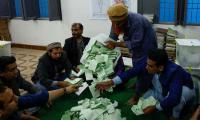Robert Mugabe was Zimbabwe’s prime minister from 1980 to 1987 and then the president of the country for the past 30 years. The Atlantic, a Massachusetts-based magazine, carried a detailed analysis on ‘How to kill a country’. According to The Atlantic: “Zimbabwe, one of southern Africa’s most prosperous countries, held great promise.”.
After 37 years of Mugabe at the helm, “Zimbabwe is as broken as any country on the planet. The country’s economy in 1997 was the fastest growing in all of Africa; now it is the fastest shrinking...How could the breadbasket of Africa have deteriorated so quickly into the continent’s basket case? The answer is Robert Mugabe who by his actions has compiled something of a “how-to” manual for national destruction”.
How to kill a country? Step 1: Destroy the engine of productivity. Pakistan is 6,957 kilometres away from Zimbabwe. In 2005, the share of manufacturing as a percentage of the GDP was 18.56 percent – the highest figure recorded in the history of Pakistan’s manufacturing sector. By 2006, a wave of premature deindustrialisation had taken over and by 2017 the share of manufacturing in our GDP has fallen to 13.5 percent. Red alert: Pakistan has sunk into premature deindustrialisation whereby the Pakistani economy is fast becoming a service economy without reaching its peak industrialisation potential.
How to kill a country? Step 2: Legislate the impossible. According to The Atlantic: “for all the lawlessness in Zimbabwe, the country in fact suffers from an overabundance of laws”. The Senate of Pakistan passed yet another law – the Election Reforms Bill 2017. On October 2, President Mamnoon Hussain signed the bill and made it a law. On October 3, a prime minister disqualified by the Supreme Court became the president of Pakistan’s largest political party.
How to kill a country? Step 3: Teach hate. In Pakistan, the genuine educational space was long usurped by the forces of hate, violence and that of extremism. What we have is a primary and secondary school environment that is consciously manufactured to nurture terror, promote prejudice and breed extremism. Our curriculum of hate is breeding closet bombers who wholeheartedly support the ideals of suicide bombers who are being produced elsewhere.
How to kill a country? Step 4: Scare off foreigners. According to the Global Terrorism Index (GTI), “The countries most heavily affected by terrorism in 2011 were Iraq, Pakistan, Afghanistan, India and Yemen”. The latest from GTI is: “Pakistan recorded a decrease in the number of people killed by terrorism with a 12 percent reduction to 956 deaths. This is the lowest number of deaths since 2006.”
The corporate tax rate in Pakistan is 38 percent, which is one of the highest –if not the highest-on the face of the planet. Companies registered in Pakistan must pay 47 different taxes as oppose to three in Hong Kong. And, it takes 311 hours per year to comply with tax regulations in Pakistan as oppose to 55 in Luxemburg.
On November 10, General Chiwenga, Zimbabwe’s army general, visited Beijing. On November 15, the military took over. According to The Guardian: “If so, the world may just have witnessed the first example of a covert coup d’etat of the kind once favoured by the CIA and Britain’s MI6, but conceived and executed with the tacit support of the 21st century’s new global superpower”.
Credit goes to Mugabe (whose assets outside Zimbabwe are estimated at over $1.5 billion) for becoming the first president to have written the ‘how-to’ manual for national destruction.
The writer is a columnist based in Islamabad.
Email: farrukh15@hotmail.com
Twitter: @saleemfarrukh
There are over 11 million Pakistanis settled abroad, out of which around six million work in Gulf and Middle East
This year alone, US Treasury would have to roll-over $10 to $14 trillion in maturing short-term debt
Tear gas no longer marks just protest sites; it paints entire cities as battlegrounds but then again, PTI did it first
Political structures and governance systems have been central to economic and social development
It is confirmed now 40 Pakistanis had died after boat of migrants had capsized in sea near Greece
Many people believe that in future, AI will play an even more significant role in their lives







